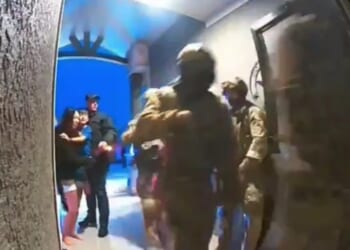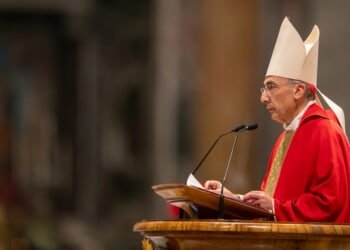For years, Jordan’s government opted to contain rather than confront the Muslim Brotherhood. That strategy has failed.
Jordan has entered a new phase in its campaign against the Muslim Brotherhood. On May 14, the Jordanian government issued an ultimatum: “anyone in possession of movable or immovable assets once owned by the Muslim Brotherhood or registered in its name, including property, funds, and other holdings,” must report them to the Ministry of Social Development within a month—or face legal action.
The asset seizure order comes on the heels of a security crackdown. On April 23, Interior Minister Mazen al-Farayya declared the Muslim Brotherhood illegal in its entirety, just days after authorities arrested sixteen of its members for allegedly producing rockets, building drones, and coordinating with foreign actors, marking an end to years of cautious tolerance for the group’s activities.
The Brotherhood’s vehement opposition to Jordan’s 1994 peace deal with Israel set the tone for its strained relationship with the monarchy. This tension intensified during the uprisings of the Arab Spring, which toppled regimes across the Middle East. Yet the Jordanian Brotherhood did not take part in violent demonstrations, unlike other branches of the movement across the region. Unlike neighboring states, Jordan chose to manage the Brotherhood through containment. But that policy has now unraveled.
On April 15, Amman’s General Intelligence Directorate reported that the thwarted plans that started in 2021 included “manufacturing rockets and drones, possession of explosives and firearms and recruiting operatives in Jordan and abroad.”
The Jordanian state has traditionally exercised caution when announcing foiled terror plots—releasing sparse statements with no names, affiliations, or specific locations. A telling example came in June 2024, when authorities uncovered explosives in an Amman suburb but withheld all identifying details.
This time, instead of discretion, the government launched a full-scale media campaign: the minister of information held a televised press conference, followed by the release of confession videos showing suspects detailing their plans, full names, and, most notably, their ties to the Muslim Brotherhood.
Tensions had already escalated in the months before this announcement as the Brotherhood’s stance on protests deepened its rift with the Jordanian government. In March, King Abdullah II issued a stark warning that “there are people among us taking orders from the outside”—widely interpreted as a rebuke of the Brotherhood’s alignment with Hamas. In the streets, protesters affiliated with the Muslim Brotherhood shouted, “All of Jordan is Hamas,” and praised slain Hamas leaders with chants like, “Put the sword on the sword, we are your men, Mohammad Deif.”
The Brotherhood distanced itself from the foiled plot, calling it the work of “individuals acting in support of the resistance”—a familiar tactic of plausible deniability. Among the accused are former members of the Brotherhood’s senior advisory body, the Shura Council, revealing the group’s direct entanglement in the affair. Since its inception, the organization has relied on similar excuses to deflect blame for violent actions by those in its orbit.
A defining example dates to the 1940s, when the Muslim Brotherhood’s Egyptian branch formed a clandestine armed wing that carried out a string of assassinations, including the killing of Prime Minister Mahmoud El-Nokrashy. Confronted with mounting pressure, Brotherhood founder Hassan al-Banna famously disavowed the perpetrators, declaring, “These are neither brothers nor Muslims.” The Brotherhood’s leadership has since wielded that phrase as a rhetorical shield—invoking it time and again whenever violence traces back to its fold.
Even Hamas weighed in, issuing a statement on April 22 demanding the “immediate release” of the detainees and hailing their “honorable, patriotic motives.” The group insisted the men acted “out of solidarity with Palestine” and had no intention of threatening Jordan’s security or stability.
Nevertheless, these justifications hold no weight with Jordanian authorities. First, tying the cell’s activities to the Palestinian cause is a well-worn tactic designed to evoke public sympathy, and the facts refute it. Second, Jordan is a sovereign state governed by strict regulations that prohibit weapons manufacturing, especially for militant use.
Claims that these arms were for Palestinian factions are implausible; armed groups in Gaza and the West Bank had relied on weapons transported originating from Iran, Lebanon, and Syria, not Jordan, which has never been a hub for weapons production. Third, the plots date back to 2021—well before Hamas’ October 2023 attack on Israel—further undercutting claims that it was a reaction to recent events.
Finally, evidence released by Jordanian authorities shows the cell received funding from abroad, including connections to Hamas in Lebanon and Hezbollah—actors long viewed by Amman as destabilizing forces. The Brotherhood’s claim these weapons were meant for Gaza collapses under scrutiny. Every detail—range, funding, timing—points to an internal plot.
The backlash against the Muslim Brotherhood did not stop at Jordan’s borders—it echoed across the region. In anti-Brotherhood states like the UAE, the coverage was unequivocal. For example, Al-Ain, a UAE-based outlet, declared that “Jordanian security forces have dealt a fresh blow to the Muslim Brotherhood, thwarting its latest plot to destabilize the country.”
In sharp contrast, Qatar’s Al Jazeera—long accused of serving as a platform for Muslim Brotherhood propaganda—downplayed the implications of the plot. The network was the first to report on the Brotherhood’s denials and framed the arrests as against individuals allegedly acting in support of Palestinian resistance, not against Jordan.
The Brotherhood may be banned, but its political arm—the Islamic Action Front (IAF)—still commands ample public support. Whether that will remain true is now in serious doubt. Jordanian authorities dissolved the Brotherhood in 2020 after it failed to register as a charity. Still, that ruling was not enforced and did not ban the IAF, which continued to operate and, in 2024, emerged as the largest bloc in parliament with thirty-one seats—momentum that could now falter under the weight of its Brotherhood ties. The IAF has now distanced itself, claiming its leadership is “independent of any other entity.”
Now, the government’s posture is unmistakably firm: no dialogue. MP Mohammad Aqel, the IAF’s liaison with the state, admitted, “No one is answering us.” In parallel, Jordanian authorities arrested Arif Hamdan—making him the fourth Shura Council member detained in the fallout.
What comes next could reshape Jordan’s political future. A formal prohibition of the IAF would necessitate judicial endorsement and action by the electoral authorities. But even if Amman does not go that far, enforcing the Brotherhood’s ban will likely bleed into the IAF’s base—crippling it ahead of the 2028 elections. Even if the IAF avoids dissolution, severing its Brotherhood-backed resources will likely diminish its electoral viability.
Criminalizing the Brotherhood raises the risk of the group going underground, a shift that historically coincided with a surge in extremist violence, as seen in Egypt during the 1990s. Amman’s long-standing approach of oversight without confrontation has collapsed in the face of escalating threats. The danger now is a covert, radicalized network that poses a greater threat to national security. Jordan may have eliminated a public threat, but in doing so, it risks birthing a covert one—harder to see, harder to track, and far more dangerous.
About the Author: Ahmad Sharawi
Ahmad Sharawi is a research analyst at The Foundation for Defense of Democracies, focusing on Middle East affairs and the Levant.
Image: Lena Ha / Shutterstock.com.













